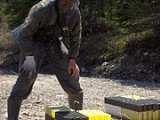
Treeplanting
Encyclopedia
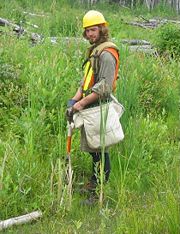
Transplanting
For botanical organ transplant, see GraftingIn agriculture and gardening, transplanting or replanting is the technique of moving a plant from one location to another. Most often this takes the form of starting a plant from seed in optimal conditions, such as in a greenhouse or protected nursery...
tree seedling
Seedling
thumb|Monocot and dicot seedlingsA seedling is a young plant sporophyte developing out of a plant embryo from a seed. Seedling development starts with germination of the seed. A typical young seedling consists of three main parts: the radicle , the hypocotyl , and the cotyledons...
s, generally for forestry
Forestry
Forestry is the interdisciplinary profession embracing the science, art, and craft of creating, managing, using, and conserving forests and associated resources in a sustainable manner to meet desired goals, needs, and values for human benefit. Forestry is practiced in plantations and natural stands...
, land reclamation
Land reclamation
Land reclamation, usually known as reclamation, is the process to create new land from sea or riverbeds. The land reclaimed is known as reclamation ground or landfill.- Habitation :...
, or landscaping
Landscaping
Landscaping refers to any activity that modifies the visible features of an area of land, including:# living elements, such as flora or fauna; or what is commonly referred to as gardening, the art and craft of growing plants with a goal of creating a beautiful environment within the landscape.#...
purposes. It differs from the transplantation of larger trees in arboriculture
Arboriculture
Arboriculture is the cultivation, management, and study of individual trees, shrubs, vines, and other perennial woody plants. It is both a practice and a science....
, and from the lower cost but slower and less reliable distribution of tree seed
Seed
A seed is a small embryonic plant enclosed in a covering called the seed coat, usually with some stored food. It is the product of the ripened ovule of gymnosperm and angiosperm plants which occurs after fertilization and some growth within the mother plant...
s.
In silviculture
Silviculture
Silviculture is the practice of controlling the establishment, growth, composition, health, and quality of forests to meet diverse needs and values. The name comes from the Latin silvi- + culture...
the activity is known as reforestation
Reforestation
Reforestation is the natural or intentional restocking of existing forests and woodlands that have been depleted, usually through deforestation....
, or afforestation, depending on whether the area being planted has or has not recently been forested. It involves planting seedlings over an area of land where the forest
Forest
A forest, also referred to as a wood or the woods, is an area with a high density of trees. As with cities, depending where you are in the world, what is considered a forest may vary significantly in size and have various classification according to how and what of the forest is composed...
has been harvested or damaged by fire or disease or insects. Tree planting is carried out in many different parts of the world, and strategies may differ widely across nations and regions and among individual reforestation companies. Tree planting is grounded in forest science, and if performed properly can result in the successful regeneration of a deforested area. Reforestation is the commercial logging
Logging
Logging is the cutting, skidding, on-site processing, and loading of trees or logs onto trucks.In forestry, the term logging is sometimes used in a narrow sense concerning the logistics of moving wood from the stump to somewhere outside the forest, usually a sawmill or a lumber yard...
industry's answer to the large-scale destruction of old growth forest
Old growth forest
An old-growth forest is a forest that has attained great age , and thereby exhibits unique ecological features. An old growth forest has also usually reached a climax community...
s, but a planted forest rarely replicates the biodiversity
Biodiversity
Biodiversity is the degree of variation of life forms within a given ecosystem, biome, or an entire planet. Biodiversity is a measure of the health of ecosystems. Biodiversity is in part a function of climate. In terrestrial habitats, tropical regions are typically rich whereas polar regions...
and complexity of a natural forest.
Because trees remove carbon dioxide
Carbon dioxide
Carbon dioxide is a naturally occurring chemical compound composed of two oxygen atoms covalently bonded to a single carbon atom...
from the air as they grow, tree planting can be used as a geoengineering
Geoengineering
The concept of Geoengineering refers to the deliberate large-scale engineering and manipulation of the planetary environment to combat or counteract anthropogenic changes in atmospheric chemistry The Intergovernmental Panel on Climate Change concluded in 2007 that geoengineering options, such...
technique to remove
Carbon dioxide
Carbon dioxide is a naturally occurring chemical compound composed of two oxygen atoms covalently bonded to a single carbon atom...
from the atmosphere
Atmosphere
An atmosphere is a layer of gases that may surround a material body of sufficient mass, and that is held in place by the gravity of the body. An atmosphere may be retained for a longer duration, if the gravity is high and the atmosphere's temperature is low...
.
Canada
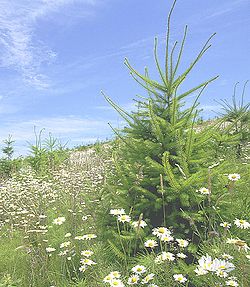
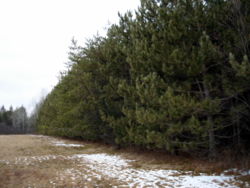
Canada
Canada is a North American country consisting of ten provinces and three territories. Located in the northern part of the continent, it extends from the Atlantic Ocean in the east to the Pacific Ocean in the west, and northward into the Arctic Ocean...
is carried out by private reforestation companies. Reforestation companies compete with one another for contracts from logging companies, whose annual allowable cut for the following year is based upon how much money
Money
Money is any object or record that is generally accepted as payment for goods and services and repayment of debts in a given country or socio-economic context. The main functions of money are distinguished as: a medium of exchange; a unit of account; a store of value; and, occasionally in the past,...
they invest into reforestation and other silvicultural practices. Treeplanting is typically piece work
Piece work
Piece work is any type of employment in which a worker is paid a fixed "piece rate" for each unit produced or action performed regardless of time...
and tree prices can vary widely depending on the difficulty of the terrain and on the winning contract's bid price. As a result, there is a saying among planters: "There is no bad land, only bad contracts."
Tree planting crews often do not permanently reside in the areas where they work, thus much planting is based out of motels or bush camps. Bush camp accommodations usually consist of a mess tent, cook shack, dry goods tent, first aid tent, freshly dug outhouses, and a shower tent or trailer. Planters are responsible for bringing either a tent or car to sleep in. A camp also contains camp cooks and support staff.
Planting is carried out in accordance to the client's specifications, and planters are expected to learn the quality standards for each contract that they work on. Planted clearcuts
Clearcutting
Clearcutting, or clearfelling, is a controversial forestry/logging practice in which most or all trees in an area are uniformly cut down. Clearcutting, along with shelterwood and seed tree harvests, is used by foresters to create certain types of forest ecosystems and to promote select species that...
are spot checked on a regular basis. Although quality concerns vary across contracts, spot checkers are typically looking for such things as: species appropriate site choice, species appropriate spacing, how tight the seedlings are in the ground, how straight the seedlings are, and whether or not the seedlings have been damaged. These concerns vary from region to region, and from contract to contract.
The average British Columbian planter plants 1 600 trees per day, but it is not uncommon for veterans to plant 2000-3000 trees per day while working in the interior. These numbers are higher in central and eastern Canada, where the terrain is generally faster, however the price per tree is slightly lower as a result. Average daily totals of 2500 are common, with experienced planters planting upwards of 5000 trees a day. Numbers as high as 7500 a day have been recorded. Planters typically work 8–10 hours per day with an additional 1 to 2 hours of (usually) unpaid traveling time. Work weeks on British Columbian planting contracts are usually 4–5 days long, with 1–2 days off. In Ontario
Ontario
Ontario is a province of Canada, located in east-central Canada. It is Canada's most populous province and second largest in total area. It is home to the nation's most populous city, Toronto, and the nation's capital, Ottawa....
, work weeks are generally 5–6 days long, with 1 day off.
Quite often, tree planting contractors will deduct some of the cost associated with the operation of the contract directly from the tree planter's daily earned wages. These imposed fees typically vary from $10 to $30 per day, and are referred to as "camp costs". In some cases, rookie tree planters end up owing their employer money for the first few pay periods.
Once inflation is factored in, real tree planter earnings have declined for many years in Canada. This has adversely affected the sector's ability to attract and retain workers. Higher wages and much better working conditions in many other industries, from construction, to oil and gas, and even information technology
Information technology
Information technology is the acquisition, processing, storage and dissemination of vocal, pictorial, textual and numerical information by a microelectronics-based combination of computing and telecommunications...
, has led to fewer Canadian young people wanting to plant trees.
Based on statistics for British Columbia, the average tree planter: lifts a cumulative weight of over 1000 kilograms (2,204.6 lb), bends more than 200 times per hour, drives the shovel into the ground more than 200 times per hour and travels over 16 kilometres (9.9 mi) with a heavy load, every day of the entire season. The reforestation industry has an average annual injury rate of approximately 22 claims per 100 workers, per year. It is often difficult and sometimes dangerous.
Great Britain
Planting in Britain is commonly referred to as restocking, when it takes place on land that has recently been harvestedLogging
Logging is the cutting, skidding, on-site processing, and loading of trees or logs onto trucks.In forestry, the term logging is sometimes used in a narrow sense concerning the logistics of moving wood from the stump to somewhere outside the forest, usually a sawmill or a lumber yard...
. When occurring on previously unforested land it is known as new planting. Under the British system, in order to acquire the necessary permissions to clearcut, the landowner must agree a management plan with the Forestry Commission
Forestry Commission
The Forestry Commission is a non-ministerial government department responsible for forestry in Great Britain. Its mission is to protect and expand Britain's forests and woodlands and increase their value to society and the environment....
(the regulatory body for all things forestry) which must include proposals for the re-establishment of tree cover on the land. Planting contractors will be engaged by the landowner/management company, a contract drawn up and work will typically take place from November to April when the transplants are dormant
Dormancy
Dormancy is a period in an organism's life cycle when growth, development, and physical activity are temporarily stopped. This minimizes metabolic activity and therefore helps an organism to conserve energy. Dormancy tends to be closely associated with environmental conditions...
.
Planting is part of the rotational nature of much British plantation
Plantation
A plantation is a long artificially established forest, farm or estate, where crops are grown for sale, often in distant markets rather than for local on-site consumption...
forestry. Productive tree crops are planted and subsequently clearcut. Some form of soil cultivation
Tillage
Tillage is the agricultural preparation of the soil by mechanical agitation of various types, such as digging, stirring, and overturning. Examples of human-powered tilling methods using hand tools include shovelling, picking, mattock work, hoeing, and raking...
may take place and the ground is then restocked. Where the production of timber is a management priority, a prescribed stocking density
Stocking (forestry)
In forestry, stocking , is a quantitative measure of the area occupied by trees, usually measured in terms of well-spaced trees or basal area per hectare, relative to an optimum or desired level of density...
must be achieved. For coniferous species this will be a minimum of 2500 stems per hectare at year 5 (from planting). Planting at this density has been shown to favour the development of straighter knot-free logs
Sawlog
The term sawlog refers to that part of a tree stem that will be processed at a sawmill. This is in contrast to those other parts of the stem that are designated pulpwood. The differences are that sawlogs will be greater in diameter, straighter and have a lower knot frequency.Sawlogs most often come...
.
Planters are normally paid under piece work
Piece work
Piece work is any type of employment in which a worker is paid a fixed "piece rate" for each unit produced or action performed regardless of time...
terms and an experienced worker will plant around 1500 trees a day under most conditions.
Israel
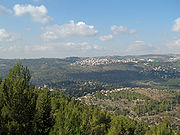
Israel
The State of Israel is a parliamentary republic located in the Middle East, along the eastern shore of the Mediterranean Sea...
is one of only two countries worldwide, that entered the 21st century with a net gain in the number of trees. Due to massive afforestation efforts, this fact echoed in diverse campaigns. The various forests of Israel today are mainly the result of a great afforestation campaign by the Jewish National Fund
Jewish National Fund
The Jewish National Fund was founded in 1901 to buy and develop land in Ottoman Palestine for Jewish settlement. The JNF is a quasi-governmental, non-profit organisation...
(JNF). Some well-known forests of contemporary Israel, out of the list of forests in Israel, are:
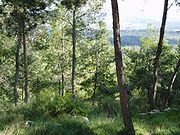
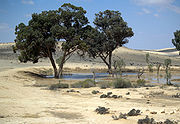
- the Hulda Forest or Herzl Forest (Ya'ar Hulda), a wood in central Israel between Kibbutz Hulda and Kibbutz Mishmar David, SE to Rehovot. Planted in 1907 by the Jewish National Fund, it was dedicated to the memory of Theodor HerzlTheodor HerzlTheodor Herzl , born Benjamin Ze’ev Herzl was an Ashkenazi Jew Austro-Hungarian journalist and the father of modern political Zionism and in effect the State of Israel.-Early life:...
and serves today as a public park and nature resort. - the Forest of the MartyrsForest of the MartyrsThe Forest of the Martyrs is a forest on the outskirts of Jerusalem, Israel. It is on the western edge of Eshtaol Forest near Beit Meir...
(Ya'ar HaKdoshim), a forest on the outskirts of Jerusalem, near Beit MeirBeit MeirBeit Meir is a religious moshav in central Israel. Located in the Jerusalem hills around nine miles from Jerusalem, just off the Jerusalem-Tel Aviv highway, it falls under the jurisdiction of Mateh Yehuda Regional Council. In 2006 it had a population of 546...
. Planted as a memorial to the victims of the Holocaust, eventually it will contain six million trees as a symbol for the six million Jews who perished at the hands of the german Nazis in World War IIWorld War IIWorld War II, or the Second World War , was a global conflict lasting from 1939 to 1945, involving most of the world's nations—including all of the great powers—eventually forming two opposing military alliances: the Allies and the Axis...
. - the Jerusalem ForestJerusalem ForestThe Jerusalem Forest is a pine forest located in the Judean Mountains west of Jerusalem. It is surrounded by the Jerusalem neighborhoods Beit HaKerem, Yefe Nof, Ein Kerem, Har Nof, Givat Shaul, and a moshav, Beit Zeit. The forest was planted during the 1950s by the Jewish National Fund, financed by...
, a pinePinePines are trees in the genus Pinus ,in the family Pinaceae. They make up the monotypic subfamily Pinoideae. There are about 115 species of pine, although different authorities accept between 105 and 125 species.-Etymology:...
forest in the Judean MountainsJudean MountainsThe Judaean Mountains, ;, also Judaean Hills and Hebron Hills is a mountain range in Israel and the West Bank where Jerusalem and several other biblical cities are located. The mountains reach a height of 1,000 m.-Geography:...
west of Jerusalem. Planted during the 1950s by the Jewish National FundJewish National FundThe Jewish National Fund was founded in 1901 to buy and develop land in Ottoman Palestine for Jewish settlement. The JNF is a quasi-governmental, non-profit organisation...
and financed by private donors, the forest extends today over about 1.2 square kilometres, with the Yad VashemYad VashemYad Vashem is Israel's official memorial to the Jewish victims of the Holocaust, established in 1953 through the Yad Vashem Law passed by the Knesset, Israel's parliament....
museum near Mount HerzlMount HerzlMount Herzl , also Har HaZikaron , is the national cemetery of Israel on the west side of Jerusalem. It is named for Theodor Herzl, the founder of modern political Zionism. Herzl's tomb lies at the top of the hill. Yad Vashem, which commemorates the Holocaust, lies to the west of Mt. Herzl....
. - the Yatir ForestYatir ForestYatir Forest is a forest in Israel, located on the southern slopes of Mount Hebron, on the edge of the Negev Desert. The forest covers an area of 30,000 dunams , and is the largest planted forest in Israel.-History:...
, located on the southern slopes of Mount HebronMount HebronMount Hebron is a geographic region and geologic formation in the southern West Bank, with its western foothills extending into Israel. The area was in biblical times a center of the Israelite and Hasmonean kingdoms. The region lends its name to the Mount Hebron Regional Council....
, on the edge of the NegevNegevThe Negev is a desert and semidesert region of southern Israel. The Arabs, including the native Bedouin population of the region, refer to the desert as al-Naqab. The origin of the word Neghebh is from the Hebrew root denoting 'dry'...
Desert. Covering an area of 30,000 dunamDunamA dunam or dönüm, dunum, donum, dynym, dulum was a non-SI unit of land area used in the Ottoman Empire and representing the amount of land that can be plowed in a day; its value varied from 900–2500 m²...
s (30 square kilometers), it is the largest planted forest in Israel. It is named after the ancient LeviteLeviteIn Jewish tradition, a Levite is a member of the Hebrew tribe of Levi. When Joshua led the Israelites into the land of Canaan, the Levites were the only Israelite tribe that received cities but were not allowed to be landowners "because the Lord the God of Israel himself is their inheritance"...
city within its territory, YatirJattirJattir was a town in ancient Israel.)Jattir was located in the mountainous land of Judah. It was made a levitical town for priests to live. David gave some of the spoils from his battle with the Amalekite's . )Jattir is identified with Khirbet Attir southwest of Hebron....
, as written in the TorahTorahTorah- A scroll containing the first five books of the BibleThe Torah , is name given by Jews to the first five books of the bible—Genesis , Exodus , Leviticus , Numbers and Deuteronomy Torah- A scroll containing the first five books of the BibleThe Torah , is name given by Jews to the first five...
: "And unto the children of Aaron the priest they gave HebronHebronHebron , is located in the southern West Bank, south of Jerusalem. Nestled in the Judean Mountains, it lies 930 meters above sea level. It is the largest city in the West Bank and home to around 165,000 Palestinians, and over 500 Jewish settlers concentrated in and around the old quarter...
with its suburbs, the city of refuge for the manslayer, and Libnah with its suburbs, and Jattir with its suburbs, and EshtemoaEshtemoaEshtemoa, meaning obedience, is a name found in the Bible.*A son of Ishbah or maybe a town inhabited by Ishbah's descendants. *A descendent of Bithiah princess of Egypt and Mered ....
with its suburbs" (Book of JoshuaBook of JoshuaThe Book of Joshua is the sixth book in the Hebrew Bible and of the Old Testament. Its 24 chapters tell of the entry of the Israelites into Canaan, their conquest and division of the land under the leadership of Joshua, and of serving God in the land....
21:13-14). Located within the Yatir forest now is an ancient Palestinian synagoguePalestinian synagoguesPalestinian synagogues refers to synagogues which existed in ancient Palestine from antiquity up till the beginning of the Middle Ages.Most date from the Roman and Byzantine periods, from the third to seventh centuries, and relatively few synagogues have been found in from before the destruction of...
, the Anim synagogue (4th–7th centuries CE).
Afforesting the desert
The state of Israel is even afforestingAfforestation
Afforestation is the establishment of a forest or stand of trees in an area where there was no forest. Reforestation is the reestablishment of forest cover, either naturally or artificially...
the Negev
Negev
The Negev is a desert and semidesert region of southern Israel. The Arabs, including the native Bedouin population of the region, refer to the desert as al-Naqab. The origin of the word Neghebh is from the Hebrew root denoting 'dry'...
desert, which accounts for 60% of the country's land mass but remains sparsely populated. In 2006, the JNF signed a 49-year lease agreement with the State of Israel which gives it control over 30,000 hectares of Negev land for the development of forests. The JNF's 600 million dollar Blueprint Negev
Blueprint Negev
Blueprint Negev is a Jewish National Fund project to develop the Negev region of Israel.The project aims to increase the Negev's population by 250,000 new residents, improving transportation infrastructure, adding businesses and employment opportunities, preserving water resources and protecting...
aims to attract and build infrastructure for 250,000 new settlers in the Negev Desert, to meet the challenge of the massive Jewish immigration from the Soviet Union
Soviet Union
The Soviet Union , officially the Union of Soviet Socialist Republics , was a constitutionally socialist state that existed in Eurasia between 1922 and 1991....
and Ethiopia
Ethiopia
Ethiopia , officially known as the Federal Democratic Republic of Ethiopia, is a country located in the Horn of Africa. It is the second-most populous nation in Africa, with over 82 million inhabitants, and the tenth-largest by area, occupying 1,100,000 km2...
. There is a multitude of modern israeli scientific research conducted in the Yair Forest to meet the challenge of climate change
Climate change
Climate change is a significant and lasting change in the statistical distribution of weather patterns over periods ranging from decades to millions of years. It may be a change in average weather conditions or the distribution of events around that average...
, which may result in rapid plant loss and desertification in certain circumstances. Studies of the Weizmann Institute of Science
Weizmann Institute of Science
The Weizmann Institute of Science , known as Machon Weizmann, is a university and research institute in Rehovot, Israel. It differs from other Israeli universities in that it offers only graduate and post-graduate studies in the sciences....
, in collaboration with the Desert Research Institute at Sde Boker
Sde Boker
Sde Boker is a kibbutz in the Negev desert of southern Israel. Best known as the retirement home of Israel's first Prime Minister, David Ben-Gurion, it falls under the jurisdiction of Ramat HaNegev Regional Council.-History:...
, have shown that the trees function as a trap for carbon in the air. Shade provided by trees planted in the desert also reduces evaporation of the sparse rainfall. The Yatir forest is a part of the NASA
NASA
The National Aeronautics and Space Administration is the agency of the United States government that is responsible for the nation's civilian space program and for aeronautics and aerospace research...
project FluxNet
FluxNet
FluxNet is a global network of micrometeorological tower sites that use eddy covariance methods to measure the exchanges of carbon dioxide, water vapor, and energy between the biosphere and atmosphere. Fluxnet is a global 'network of regional networks' that serves to provide an infrastructure to...
, a global network of micrometeorological tower sites used to measure the exchanges of carbon dioxide
Carbon dioxide
Carbon dioxide is a naturally occurring chemical compound composed of two oxygen atoms covalently bonded to a single carbon atom...
, water vapor
Water vapor
Water vapor or water vapour , also aqueous vapor, is the gas phase of water. It is one state of water within the hydrosphere. Water vapor can be produced from the evaporation or boiling of liquid water or from the sublimation of ice. Under typical atmospheric conditions, water vapor is continuously...
, and energy between terrestrial ecosystem and atmosphere
Atmosphere
An atmosphere is a layer of gases that may surround a material body of sufficient mass, and that is held in place by the gravity of the body. An atmosphere may be retained for a longer duration, if the gravity is high and the atmosphere's temperature is low...
. The Arava Institute for Environmental Studies
Arava Institute for Environmental Studies
The Arava Institute for Environmental Studies is an accredited academic program for undergraduate and graduate studies located at Kibbutz Ketura on the Israeli side of the Arava Valley. It seeks to train future leaders of the Middle East in environmental issues so that they will be able to...
conducts research at Yatir forest that focuses on crops such as dates and grapes grown in the vicinity of Yatir forest. The research is part of a project aimed at introducing new crops into arid and saline zones.
Help for the Arab-Palestinian Authority
Since 2009, the JNF provided the Arab-Palestinian Authority with 3,000 tree seedlings for a forested area being developed on the edge of the new city of RawabiRawabi
Rawabi is the first Palestinian planned city in the West Bank. Rawabi is to be located near Ramallah and Bir Zeit. A master plan has been drawn up for the city, which will consist of 10,000 homes in six neighborhoods with a population of 40,000. Homebuyers will have access to an affordable...
, north of Ramallah.
Reforestation and forest wildfires
Approximately one thousand smaller forest fires are registered on average every year during the five fire-prone months. Half of them are caused by arsonArson
Arson is the crime of intentionally or maliciously setting fire to structures or wildland areas. It may be distinguished from other causes such as spontaneous combustion and natural wildfires...
, hostile actions and arab or palestinian terrorists attacs. Ten thousand acres of hand-planted forest were destroyed by Katyusha rockets during the 2006 Lebanon War by Hezbollah militants at the Israeli northern border region. As a response, in summer 2006, JNF launched Operation Northern Renewal, a reforestation
Reforestation
Reforestation is the natural or intentional restocking of existing forests and woodlands that have been depleted, usually through deforestation....
effort, which also replaced some topsoil that was burned away.
The Mount Carmel forest fire
Mount Carmel forest fire (2010)
The Mount Carmel forest fire was a deadly forest fire that started on Mount Carmel in northern Israel, just south of Haifa. The fire began at about 11:00 local time on 2 December 2010, and spread quickly, consuming much of the Mediterranean forest covering the region...
, the largest forest fire in Israel's history, started on December 2, 2010
December 2010
December 2010 was the twelfth month of that year. It began on a Wednesday and ended after 31 days on a Friday.-Portal:Current events:This is an archived version of Wikipedia's Current events Portal from December 2010....
and burned 41 km2 of forest.
New Zealand
Kaingaroa ForestKaingaroa Forest
Kaingaroa Forest is the largest forest in the North Island of New Zealand, and the largest plantation in the southern hemisphere.The forest covers 2900 km² in the inland East Cape and Bay of Plenty regions, and stretches south past the east coast of Lake Taupo...
in New Zealand
New Zealand
New Zealand is an island country in the south-western Pacific Ocean comprising two main landmasses and numerous smaller islands. The country is situated some east of Australia across the Tasman Sea, and roughly south of the Pacific island nations of New Caledonia, Fiji, and Tonga...
is the largest planted forest in the southern hemisphere. It is one of the many plantation forests planted since European settlement. The Monterey Pine
Monterey Pine
The Monterey Pine, Pinus radiata, family Pinaceae, also known as the Insignis Pine or Radiata Pine is a species of pine native to the Central Coast of California....
(Pinus radiata) is commonly used for plantations since a fast growing cultivar suitable for a wide range of conditions has been developed.
Government agencies, environmental organisations and private trusts carry out tree planting for conservation and climate change mitigation. While some work is carried out by private enterprise there are also planting days organised for volunteers. Landcare Research use planted forests for their EBEX21 system for greenhouse gas emissions mitigations.
United States
Trees for the Future is a non-profit organization that plants trees in developing countries to improve land management.Role in climate change
The development of markets for tradeable pollution permitsEmissions trading
Emissions trading is a market-based approach used to control pollution by providing economic incentives for achieving reductions in the emissions of pollutants....
in recent years have opened up a new source of funding for tree planting projects: carbon offsets. The creation of carbon offsets from tree planting projects hinges on the notion that trees help to mitigate climate change by sequestering carbon dioxide as they grow. However, the science linking trees and climate change is largely unsettled, and trees remain a controversial source of offsets.
Climate impacts
Climate scientists believe that human-induced global deforestation is responsible for 18-25% of global climate change. The United Nations, World Bank and other leading nongovernmental organizations are encouraging reforestation, avoided deforestation and other projects that encourage tree planting to mitigate the effects of climate change.Trees sequester carbon
Carbon dioxide sink
A carbon sink is a natural or artificial reservoir that accumulates and stores some carbon-containing chemical compound for an indefinite period. The process by which carbon sinks remove carbon dioxide from the atmosphere is known as carbon sequestration...
through photosynthesis
Photosynthesis
Photosynthesis is a chemical process that converts carbon dioxide into organic compounds, especially sugars, using the energy from sunlight. Photosynthesis occurs in plants, algae, and many species of bacteria, but not in archaea. Photosynthetic organisms are called photoautotrophs, since they can...
, converting carbon dioxide and water into molecular dioxygen (O2) and plant organic matter, such as carbohydrates (e.g., cellulose
Cellulose
Cellulose is an organic compound with the formula , a polysaccharide consisting of a linear chain of several hundred to over ten thousand β linked D-glucose units....
). Hence, forests that grow in area or density and thus increase in organic biomass will reduce atmospheric CO2 levels. (Carbon is released as CO2 if a tree or its lumber burns or decays, but as long as the forest is able to grow back at the same rate as its biomass is lost due to oxidation of organic carbon, the net result is carbon neutral.) In their 2001 assessment, the IPCC
Intergovernmental Panel on Climate Change
The Intergovernmental Panel on Climate Change is a scientific intergovernmental body which provides comprehensive assessments of current scientific, technical and socio-economic information worldwide about the risk of climate change caused by human activity, its potential environmental and...
estimated the potential of biological mitigation
Mitigation of global warming
Climate change mitigation is action to decrease the intensity of radiative forcing in order to reduce the potential effects of global warming. Mitigation is distinguished from adaptation to global warming, which involves acting to tolerate the effects of global warming...
options (mainly tree planting) is on the order of 100 Gigatonnes of carbon (cumulative) by 2050, equivalent to about 10% to 20% of projected fossil fuel emissions during that period.
However, the global cooling effect of forests from carbon sequestration is not the only factor to be considered. For example, the planting of new forests may initially release some of the area's existing carbon stores into the atmosphere. Specifically, the conversion of peat bogs into oil palm
Oil palm
The oil palms comprise two species of the Arecaceae, or palm family. They are used in commercial agriculture in the production of palm oil. The African Oil Palm Elaeis guineensis is native to West Africa, occurring between Angola and Gambia, while the American Oil Palm Elaeis oleifera is native to...
plantations has made Indonesia
Indonesia
Indonesia , officially the Republic of Indonesia , is a country in Southeast Asia and Oceania. Indonesia is an archipelago comprising approximately 13,000 islands. It has 33 provinces with over 238 million people, and is the world's fourth most populous country. Indonesia is a republic, with an...
the world's third largest producer of greenhouse gases.
Compared to less vegetated lands, forests affect climate in three main ways:
- Cooling the Earth by functioning as carbon sinksCarbon dioxide sinkA carbon sink is a natural or artificial reservoir that accumulates and stores some carbon-containing chemical compound for an indefinite period. The process by which carbon sinks remove carbon dioxide from the atmosphere is known as carbon sequestration...
, and adding water vapor to the atmosphere and thereby increasing cloudiness. - Warming the Earth by absorbing a high percentage of sunlight due to the low reflectivity of a forest's dark surfaces. This warming effect, or reduced albedoAlbedoAlbedo , or reflection coefficient, is the diffuse reflectivity or reflecting power of a surface. It is defined as the ratio of reflected radiation from the surface to incident radiation upon it...
, is large where evergreen forests, which have very low reflectivity, shade snow cover, which is highly reflective.
To date, most tree planting offsets strategies have taken only the first effect into account. A study published in December 2005 combined all these effects and found that tropical
Tropics
The tropics is a region of the Earth surrounding the Equator. It is limited in latitude by the Tropic of Cancer in the northern hemisphere at approximately N and the Tropic of Capricorn in the southern hemisphere at S; these latitudes correspond to the axial tilt of the Earth...
forestation has a large net cooling effect, because of increased cloudiness and because of high tropical growth and carbon sequestration
Carbon dioxide sink
A carbon sink is a natural or artificial reservoir that accumulates and stores some carbon-containing chemical compound for an indefinite period. The process by which carbon sinks remove carbon dioxide from the atmosphere is known as carbon sequestration...
rates.
Trees grow three times faster in the tropics than in temperate zones
Temperate
In geography, temperate or tepid latitudes of the globe lie between the tropics and the polar circles. The changes in these regions between summer and winter are generally relatively moderate, rather than extreme hot or cold...
; each tree in the rainy tropics removes about 22 kilograms (50 pounds) of carbon dioxide from the atmosphere each year. However, this study found little to no net global cooling from tree planting in temperate climates, where warming due to sunlight absorption by trees counteracts the global cooling effect of carbon sequestration. Furthermore, this study confirmed earlier findings that reforestation of colder regions — where long periods of snow cover, evergreen trees, and slow sequestration rates prevail — probably results in global warming. According to Ken Caldeira
Ken Caldeira
Ken Caldeira is an atmospheric scientist who works at the Carnegie Institution for Science's . He researches ocean acidification, climate effects of trees, intentional climate modification, and interactions in the global Carbon cycle/climate system...
, a study co-author from the Carnegie Institution for Science
Carnegie Institution for Science
The Carnegie Institution for Science is an organization in the United States established to support scientific research....
, "To plant forests outside of the tropics to mitigate climate change is a waste of time.".
His premise that grassland reflects more sun, keeping temperatures lower, is, however, applicable only in arid regions. A well-watered lawn, for example, is as green as a tree, but absorbs far less CO2. Deciduous
Deciduous
Deciduous means "falling off at maturity" or "tending to fall off", and is typically used in reference to trees or shrubs that lose their leaves seasonally, and to the shedding of other plant structures such as petals after flowering or fruit when ripe...
trees also have the advantage of providing shade in the summer and sunlight in the winter; so these trees, when planted close to houses, can be utilized to help increase energy efficiency of these houses.
This study remains controversial and criticized for assuming dark colored trees might replace the frozen, white tundra in the upper northern hemisphere. Regular tree planting projects typically take place on lands that are only slightly different in color. The warming impact was also measured over hundreds of years, rather than a 30-70 year time horizon most climate experts believe we have to fix climate change.
Furthermore, the described warming effect (of temperate and boreal latitude forest) is only apparent once the trees have grown to create a dense 'close canopy', and it is at precisely this point that trees grown for offset purposes should be harvested and their absorbed carbon fixed for the long-term as timber.
Costs
While the benefits of tree planting are subject to debate, the costs are low compared to many other mitigation options. The IPCCIntergovernmental Panel on Climate Change
The Intergovernmental Panel on Climate Change is a scientific intergovernmental body which provides comprehensive assessments of current scientific, technical and socio-economic information worldwide about the risk of climate change caused by human activity, its potential environmental and...
has concluded that "The mitigation costs through forestry can be quite modest (US$0.1–US$20 / metric ton carbon dioxide) in some tropical developing countries.... The costs of biological mitigation, therefore, are low compared to those of many other alternative measures". The cost effectiveness of tropical reforestation is due not only to growth rate, but also to farmers from tropical developing countries
Developing country
A developing country, also known as a less-developed country, is a nation with a low level of material well-being. Since no single definition of the term developing country is recognized internationally, the levels of development may vary widely within so-called developing countries...
who voluntarily plant and nurture tree species which can improve the productivity of their lands. As little as US$90 will plant 900 trees, enough to annually remove as much carbon dioxide as is annually generated by the fossil-fuel usage of an average United States resident.
Types of trees planted

Monoculture
Monoculture is the agricultural practice of producing or growing one single crop over a wide area. It is also known as a way of farming practice of growing large stands of a single species. It is widely used in modern industrial agriculture and its implementation has allowed for large harvests from...
s of eucalyptus
Eucalyptus
Eucalyptus is a diverse genus of flowering trees in the myrtle family, Myrtaceae. Members of the genus dominate the tree flora of Australia...
where they are not native species, can devastate the lands of the local people. However, it is often much more profitable to outside interests to plant non-native fast-growing trees, such as eucalyptus or pine
Pine
Pines are trees in the genus Pinus ,in the family Pinaceae. They make up the monotypic subfamily Pinoideae. There are about 115 species of pine, although different authorities accept between 105 and 125 species.-Etymology:...
(e.g., Pinus radiata or Pinus caribaea), even though the environmental and biodiversity benefits of such monoculture
Monoculture
Monoculture is the agricultural practice of producing or growing one single crop over a wide area. It is also known as a way of farming practice of growing large stands of a single species. It is widely used in modern industrial agriculture and its implementation has allowed for large harvests from...
plantations are not comparable to native forest, and such offset projects are frequently objects of controversy (see below).
To promote the growth of native ecosystems, many environmentalists advocate only indigenous trees be planted. A practical solution is to plant tough, fast-growing native tree species which begin rebuilding the land. Planting non-invasive trees that assist in the natural return of indigenous species is called "assisted natural regeneration." There are many such species that can be planted, of which about 12 are in widespread use, such as Leucaena leucocephala
Leucaena
Leucaena is a genus of flowering plants in the subfamily Mimosoideae of the legume family Fabaceae. It contains about 24 species of trees and shrubs, which are commonly known as Leadtrees. They are native to the Americas, ranging from Texas in the United States south to Peru...
.
See also
- TubestockTubestockTubestock is the plural term for young plants ready for revegetation. Tubestock go through a process which involves a large consumption of water. The plastic tubes that the plant grows in are about 8 cm tall with a diameter of 4.25 cm are tightly filled with potting mix peat moss and...
- Plant-for-the-PlanetPlant-for-the-PlanetPlant-for-the-Planet is a children’s initiative that aims to raise awareness amongst children and adults about the issues of climate change and global justice...
, a children’s initiative for tree planting - United Nations Billion Tree CampaignUnited Nations Billion Tree CampaignPlant for the Planet: Billion Tree Campaign is a worldwide tree planting campaign established by the United Nations Environment Programme with the goal of a billion trees being planted during 2007...
External links
- Selkirk College - Canadian research on treeplanting injury prevention
- TreePlant Wire - Canadian tree-planting news wire service
- Hard-Core Tree Planters - Advice from a tree planting veteran
- Tree-Planter.com - Information on tree planting as a job and community tips
- UNEP Billion Tree Campaign - United Nations indigenous tree-planting project
- Marlin Olynyk Photography - Documentary Photography of Canadian Tree Planters
- Most Tree Plantation in 24 Hour in Multiple Location World Records in India.

